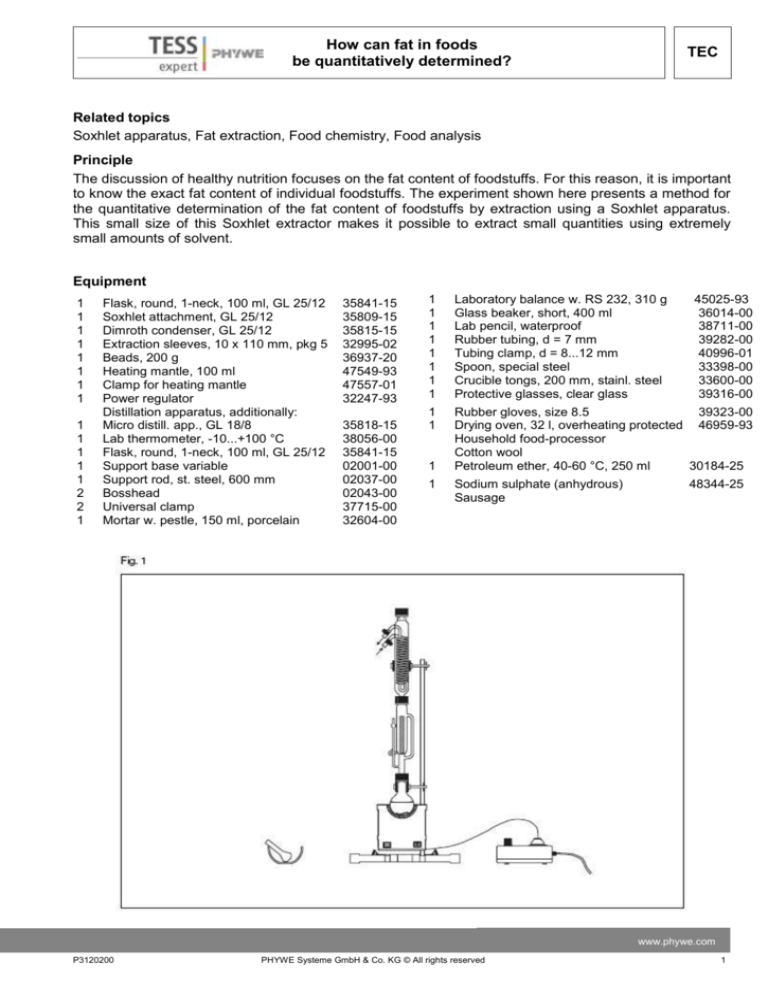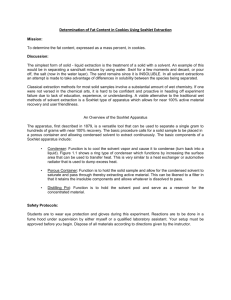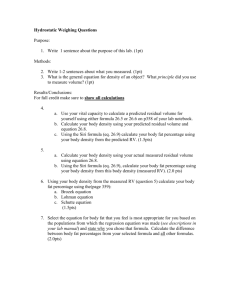
How can fat in foods
be quantitatively determined?
TEC
Related topics
Soxhlet apparatus, Fat extraction, Food chemistry, Food analysis
Principle
The discussion of healthy nutrition focuses on the fat content of foodstuffs. For this reason, it is important
to know the exact fat content of individual foodstuffs. The experiment shown here presents a method for
the quantitative determination of the fat content of foodstuffs by extraction using a Soxhlet apparatus.
This small size of this Soxhlet extractor makes it possible to extract small quantities using extremely
small amounts of solvent.
Equipment
1
1
1
1
1
1
1
1
1
1
1
1
1
2
2
1
Flask, round, 1-neck, 100 ml, GL 25/12
Soxhlet attachment, GL 25/12
Dimroth condenser, GL 25/12
Extraction sleeves, 10 x 110 mm, pkg 5
Beads, 200 g
Heating mantle, 100 ml
Clamp for heating mantle
Power regulator
Distillation apparatus, additionally:
Micro distill. app., GL 18/8
Lab thermometer, -10...+100 °C
Flask, round, 1-neck, 100 ml, GL 25/12
Support base variable
Support rod, st. steel, 600 mm
Bosshead
Universal clamp
Mortar w. pestle, 150 ml, porcelain
35841-15
35809-15
35815-15
32995-02
36937-20
47549-93
47557-01
32247-93
35818-15
38056-00
35841-15
02001-00
02037-00
02043-00
37715-00
32604-00
1
1
1
1
1
1
1
1
Laboratory balance w. RS 232, 310 g
Glass beaker, short, 400 ml
Lab pencil, waterproof
Rubber tubing, d = 7 mm
Tubing clamp, d = 8...12 mm
Spoon, special steel
Crucible tongs, 200 mm, stainl. steel
Protective glasses, clear glass
1
1
Rubber gloves, size 8.5
39323-00
Drying oven, 32 l, overheating protected 46959-93
Household food-processor
Cotton wool
Petroleum ether, 40-60 °C, 250 ml
30184-25
1
1
Sodium sulphate (anhydrous)
Sausage
45025-93
36014-00
38711-00
39282-00
40996-01
33398-00
33600-00
39316-00
48344-25
www.phywe.com
P3120200
PHYWE Systeme GmbH & Co. KG © All rights reserved
1
TEC
How can fat in foods
be quantitatively determined?
Hazards!
Petroleum ether is highly inflammable. Extinguish all open flames
before handling it! Wear protective glasses!
Task
Calculate the fat content of a sausage using soxhlet extraction.
Notes on the method
The experiment “Solubility of fats” should be carried out prior to this experiment if possible.The process
“Distillation” should be also be previously explained, or a distillation should have been previously carried
out. Dividing the experiment over two single lessons is recommended. If the fat content of different types
of sausages (or food) is measured, the results can be entered in a table and can be compared with another.
Set-up
Label a round bottom flask and put three boiling stones into it. Place the flask in a drying oven at 105°C
for 30 minutes. After the flask has cooled, in a dessicator whenever possible, determine the exact mass
of the flask. Set up a Soxhlet extraction apparatus as shown in Fig. 1. To obtain the exact fat content, the
flask must be dried to constant weight and be allowed to cool in a dessicator. To remove the solvent a
destillation apparatus is used.
Procedure
.
1. Chop up a piece of sausage with a household foodprocessor. Weigh 10 g of the chopped sausage
into a mortar and add twice the amount of sodium sulphate (anhydrous). Carefully grind the substances with the pestle.
Note: Homogenous sausages such as fine liver sausage or meat-spreads need not be homogenized with the foodprocessor. If anhydrous sodium sulphate is not available, the sausage must be
dried for several hours prior to the extraction
2. Quantitatively transfer the mixture from the mortar to an extraction thimble, e.g. using a spatula.
Wipe the mortar, pestle and spatula successively with three walnut sized pieces of cotton wool. Put
these pieces of cotton wool also in the thimble.
3. Position the extraction thimble in the Soxhlet atachment. Fill the labelled round bottom flask containing the boiling stones two thirds full with petroleum ether. Fit the flask under the Soxhlet attachment. Check the cold water circulation and switch on the heating mantle.
4. Select the heating step on the heating mantle or on the power supply at which the solvent boils in a
controlled way. Extract the sausage for at least 3 hours. When the solvent in the Soxhlet attachment is not colourless after the time given, then the extraction time must be appropriately lengthened. Remove the Soxhlet attachment and the condenser from the apparatus when the solvent in
the Soxhlet attachment has just siphoned out. Lower the heating mantle about 5 cm. Use crucible
tongs to carefully take the extraction thimble out of the Soxhlet attachment.
5. Subsequently set the apparatus up for distillation, as shown in Fig. 2. Lift the heating mantle up
under the round bottom flask and distil the whole of the petroleum ether over into the second flask.
Switch off the heating mantle and remove it immediately the boiling temperature on the thermometer drops below 50°C. The residue must not be overheated. Put the flask in a fume cupboard so
that any remaining petroleum ether can evaporate off.
6. When the residue in the flask no longer smells of solvent, place the flask in a drying oven at 105°C
2
PHYWE Systeme GmbH & Co. KG © All rights reserved
P3120200
Quantitative determination of fat
TEC
for 30 minutes. After the flask has cooled, in a dessicator whenever possible, determine the exact
mass of the flask plus the residue.
Waste disposal
The petroleum ether can either be used for further experiments or be poured into the container for combustible organic solvents.
Theory and evaluation
The fat content in foods is at the centre of attention in the discussion on a healthy diet. There is an indirect connection between overweight and fat. The use of fat in the production of foods is strictly controlled.
The fat content in foods can be quantitatively determined by extraction, using a Soxhlet apparatus.
Foods contain different amounts of fat, the fat content in sausages ranges roughly from 10% to 65%.
Certain fats are essential, and must be taken in with food.
The quantitative determination of fat with a Soxlet apparatus is a standard method in food analysis.Water
must be removed from the food prior to extraction, by grinding it with anhydrous sodium sulphate or by
heating it in a drying oven at 105°C. The dried food can then be extracted. The fat content of cheese,
nuts or fish, for example, can be determined in the way described. Fat in bread, cakes and pastries are
frequently present in a bound form. They must frequently be decomposed, e.g. with hydrochloric acid
(acc. to Weibull/Stoll) prior to the quantitative fat determination.
Hints on going deeper
This topic offers the possibility of an inter-disciplinary discussion on the aspects of nutrition. Knowledge
of food chemistry can be applied in biology lessons, e.g. the problem of the essential fatty acids, unsaturated and saturated fatty acids, or overweight.
www.phywe.com
P3120200
PHYWE Systeme GmbH & Co. KG © All rights reserved
3









